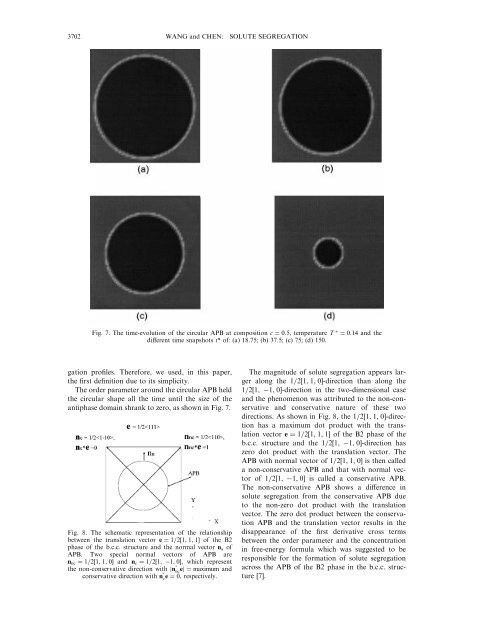solute segregation and antiphase boundary motion in a b2 single ...
solute segregation and antiphase boundary motion in a b2 single ...
solute segregation and antiphase boundary motion in a b2 single ...
You also want an ePaper? Increase the reach of your titles
YUMPU automatically turns print PDFs into web optimized ePapers that Google loves.
3702<br />
WANG <strong>and</strong> CHEN:<br />
SOLUTE SEGREGATION<br />
Fig. 7. The time-evolution of the circular APB at composition c ˆ 0:5, temperature T ˆ 0:14 <strong>and</strong> the<br />
di€erent time snapshots t* of: (a) 18.75; (b) 37.5; (c) 75; (d) 150.<br />
gation pro®les. Therefore, we used, <strong>in</strong> this paper,<br />
the ®rst de®nition due to its simplicity.<br />
The order parameter around the circular APB held<br />
the circular shape all the time until the size of the<br />
<strong>antiphase</strong> doma<strong>in</strong> shrank to zero, as shown <strong>in</strong> Fig. 7.<br />
Fig. 8. The schematic representation of the relationship<br />
between the translation vector e ˆ 1=2‰1, 1, 1Š of the B2<br />
phase of the b.c.c. structure <strong>and</strong> the normal vector n a of<br />
APB. Two special normal vectors of APB are<br />
n nc ˆ 1=2‰1, 1, 0Š <strong>and</strong> n c ˆ 1=2‰1, 1, 0Š, which represent<br />
the non-conservative direction with jn ncejˆmaximum <strong>and</strong><br />
conservative direction with n ce ˆ 0, respectively.<br />
The magnitude of <strong>solute</strong> <strong>segregation</strong> appears larger<br />
along the 1=2‰1, 1, 0Š-direction than along the<br />
1=2‰1, 1, 0Š-direction <strong>in</strong> the two-dimensional case<br />
<strong>and</strong> the phenomenon was attributed to the non-conservative<br />
<strong>and</strong> conservative nature of these two<br />
directions. As shown <strong>in</strong> Fig. 8, the 1=2‰1, 1, 0Š-direction<br />
has a maximum dot product with the translation<br />
vector e ˆ 1=2‰1, 1, 1Š of the B2 phase of the<br />
b.c.c. structure <strong>and</strong> the 1=2‰1, 1, 0Š-direction has<br />
zero dot product with the translation vector. The<br />
APB with normal vector of 1=2‰1, 1, 0Š is then called<br />
a non-conservative APB <strong>and</strong> that with normal vector<br />
of 1=2‰1, 1, 0Š is called a conservative APB.<br />
The non-conservative APB shows a di€erence <strong>in</strong><br />
<strong>solute</strong> <strong>segregation</strong> from the conservative APB due<br />
to the non-zero dot product with the translation<br />
vector. The zero dot product between the conservation<br />
APB <strong>and</strong> the translation vector results <strong>in</strong> the<br />
disappearance of the ®rst derivative cross terms<br />
between the order parameter <strong>and</strong> the concentration<br />
<strong>in</strong> free-energy formula which was suggested to be<br />
responsible for the formation of <strong>solute</strong> <strong>segregation</strong><br />
across the APB of the B2 phase <strong>in</strong> the b.c.c. structure<br />
[7].
















